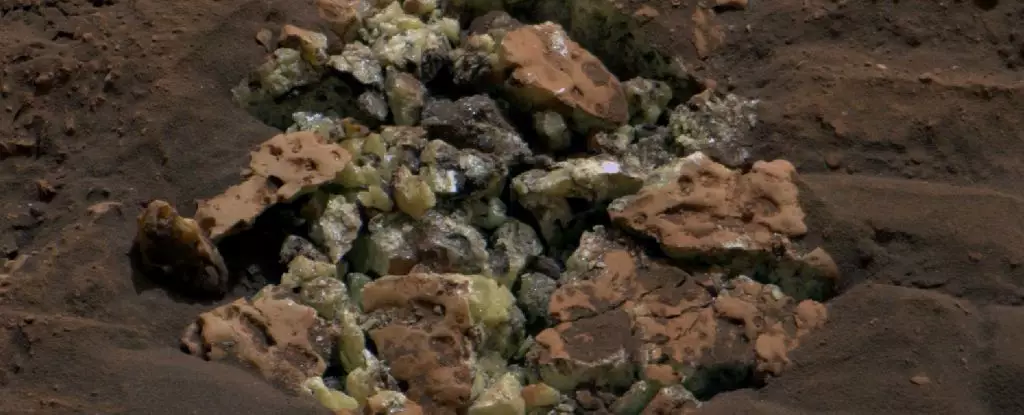Recent findings from NASA’s Curiosity rover have challenged long-held assumptions about Mars’s geological makeup. Traditionally, our understanding of the Red Planet has been shaped by the presence of sulfate minerals, which serve as telltale signs of past water activity. However, an accidental rupture of a seemingly mundane rock in the Gediz Vallis region unveiled an extraordinary mineral—pure elemental sulfur embedded within Martian crust. This discovery is far more than a scientific curiosity; it shakes the foundation of existing planetary models and invites a reevaluation of Mars’s geological history and its habitability potential.
This revelation underscores the importance of serendipity in space exploration. What initially was an incidental crack turned into a groundbreaking moment, emphasizing that sometimes progress in planetary science hinges on unexpected accidents rather than planned discoveries. Such moments remind us that despite the sophisticated instruments and thorough planning, the universe often surprises us when we least expect it.
What makes this find truly compelling is the rarity of elemental sulfur on planetary surfaces. While sulfates are common, elemental sulfur itself requires specific conditions to form and persist. Its presence on Mars suggests that the planet’s geological processes may be more complex and dynamic than previously understood. This mineral could serve as a window into unknown environmental conditions, possibly hinting at volcanic activity, geothermal processes, or other localized phenomena that could have concentrated sulfur in its pure form.
The Science and Mysteries Behind the Sulfur Deposit
Mars’s landscape has long been a record of its aqueous past, with sulfates acting as markers of water-rich environments that once existed. The detection of these salts has helped scientists reconstruct water activity, climate shifts, and planetary weathering over millions of years. In contrast, the discovery of elemental sulfur signals conditions that diverge from the norm. Pure sulfur typically forms under narrow, specific circumstances—such as volcanic eruptions or high-temperature volcanic vents—which are not documented in the region’s known geology.
The fact that such sulfur deposits are now evident on the Martian surface raises numerous questions. Could this imply that Mars once experienced more intense thermal activity or volcanic events that fostered the formation of elemental sulfur? Or does it suggest previously unknown geochemical processes capable of producing and depositing sulfur in its pure state? These are questions that keep planetary scientists up at night, eager to piece together Mars’s complex evolutionary puzzle.
Adding to the intrigue is the observation that the Gediz Vallis Channel, where the sulfur was discovered, is strewn with rocks resembling the sulfur specimen before it was shattered. This pattern suggests the presence of a sulfur-rich environment extending beyond the single find. It hints at the possibility that elemental sulfur isn’t an isolated anomaly but perhaps part of a broader mineralogical landscape. If confirmed, this could revolutionize our understanding, indicating that Mars may have regions rich in accessible elemental sulfur—an essential element for potential human colonization and life support systems.
The Implications for Habitability and Future Missions
Sulfur’s fundamental role in biochemistry is well-established on Earth. As a building block of amino acids like cysteine and methionine, sulfur is crucial for life as we know it. Its presence on Mars, especially in a form readily available for biological processes, sparks fascinating questions about the planet’s past habitability. While no currently documented signs of life have emerged, every discovery like this adds a new layer to the narrative that Mars may once have harbored conditions conducive to life.
Furthermore, this discovery impacts future exploration strategies. The detection of pure sulfur deposits suggests that regions like Gediz Vallis could serve as mineralogical treasure troves—potentially rich in resources that could support future colonization efforts. Elemental sulfur might be useful for various industrial applications, including manufacturing and energy storage, making Mars not only a scientific target but also a resource hub.
On a broader scale, these findings illustrate the importance of maintaining a flexible approach to planetary exploration. The surprises that came from a simple geological accident demonstrate that our models are still incomplete. To fully comprehend Mars’s history and potential, future missions will need to incorporate adaptable tools capable of responding dynamically to unexpected discoveries. This finding is just the tip of the iceberg, revealing that the Red Planet may still hold many secrets capable of rewriting our understanding of planetary science.
The journey of Curiosity continues, driven by both curiosity and a relentless quest for truth. With each new layer of Martian rock analyzed, we inch closer to uncovering whether Mars’s mysterious sulfur deposits are relics of volcanic activity, signs of complex chemical processes, or clues pointing to a more habitable past. The possibilities are as vast as space itself, and with each revelation, our appreciation for the planet’s secrets grows stronger.

